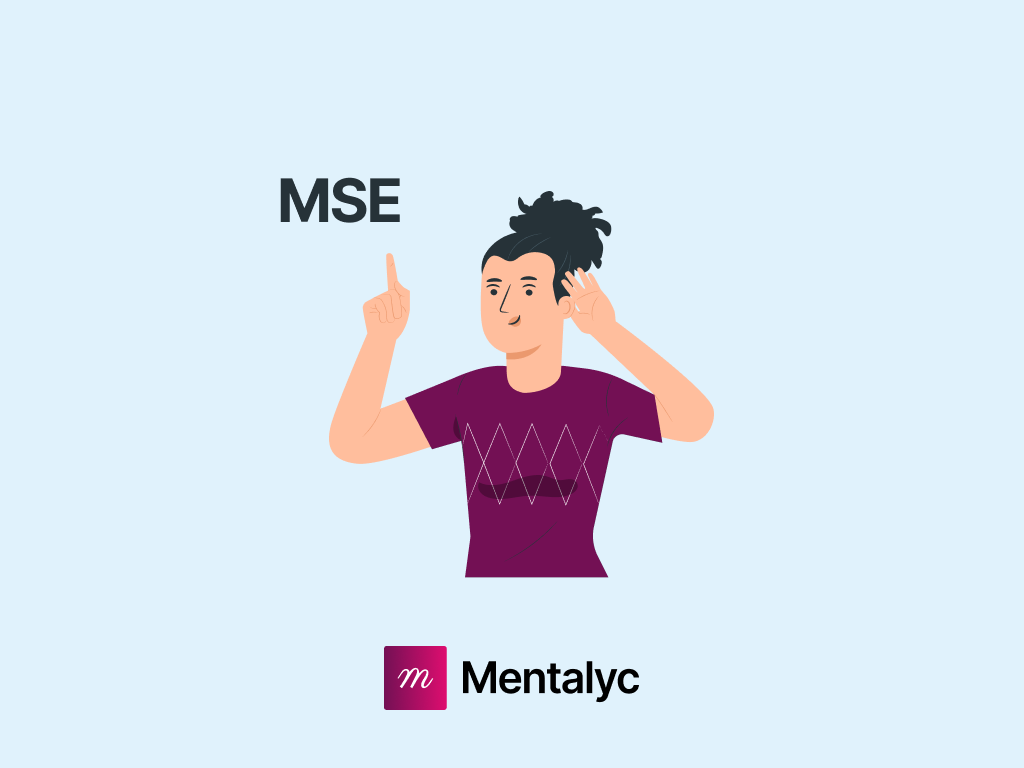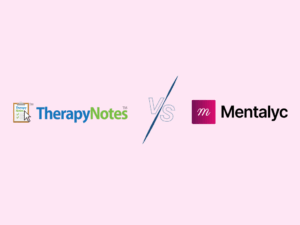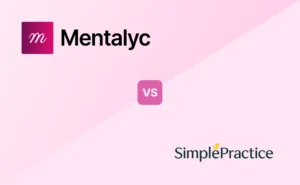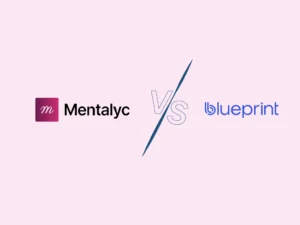As helping professionals, our first priority is to truly understand the people who turn to us for guidance.
There are many respectful ways to learn about a client’s world—sometimes it’s through quick check-ins, and other times through deeper conversations that uncover how they think, feel, and function day to day.
One of the most effective methods for this deeper exploration is the mental status examination (MSE).
Conducting a Mental Status Exam (MSE) gives clinicians a clear snapshot of a person’s current mental and emotional state. It highlights both strengths and areas of struggle, creating a foundation for thoughtful treatment planning.
In this blog, which comes with a Mental Status Exam cheat sheet, we at Mentalyc walk you through the standard components of an MSE and share practical tips on how to use it respectfully and insightfully. To make things easier, we’ve also included ready-to-use Mental Status Examination checklists and descriptors, so you can carry out comprehensive evaluations with confidence and clarity. Beyond that, we will show you how Mentalyc can support you by turning session details into clear, structured MSE documentation—accurate, compliant, and stress-free.
Setting the Stage: What is a Mental Status Exam (MSE) in Mental Health Assessment?
In mental health, professionals do not rely on intrusive physical examination techniques like palpation or auscultation. Instead, they focus on being expert observers, keenly noting both positive and negative findings to gain insights into an individual’s cognitive, emotional, and behavioral functioning. One way to achieve that is the Mental Status Examination (MSE).
Originally developed for use in psychiatry and clinical psychology, the MSE has also found its application in other helping professions like social work and coaching. It serves as a valuable tool to document and evaluate an individual’s mental state at a specific point in time.
The MSE typically involves a structured interview and systematic behavioral observations. While there may be variations in the specific forms used by different practitioners, there are core domains that should be covered in every Mental Status Exam (MSE), which we aim to tackle in this blog.
MSEs are an integral part of mental health assessments and clinical contacts. They offer a holistic assessment of a patient’s cognitive and behavioral functioning, based on both the clinician’s observations and the client’s subjective descriptions.
Think of the MSE as a psychiatrist’s version of a physical exam, but focused on mental health. It allows behavioral health professionals to create a comprehensive picture of an individual’s present moment, capturing their mental state at that specific time, identifying any areas of concern, and recognizing any potential for interventions.
Key Principles in the Approach to the Mental Status Exam (MSE) for Therapists and Counselors
When conducting a Mental Status Examination (MSE), it is essential to adhere to certain key principles to ensure a comprehensive and accurate assessment of an individual’s mental state. These principles help create a conducive environment for the patient, promote open communication, and consider various factors that may influence the assessment process. Here’s the secret recipe from Mentalyc!
Mentalyc captures all the important MSE factors, keeping them organized and always within reach in your structured mental health assessment notes. This way, you have a clear, structured record ready whenever you need it.

With Mentalyc, documenting the Mental Status Examination (MSE) becomes simple and flexible. You don’t have to use a one-size-fits-all form—instead, you can pick which MSE elements matter most for your sessions, like mood & affect, thought process & content, or speech and language. Mentalyc saves your preferences and weaves them into all your progress notes, so you’re not rewriting the same sections over and over. The result? Consistent, organized progress notes that capture the essentials without extra effort.
Welcome and Establish Comfort:
Begin the MSE by warmly welcoming the patient and clearly stating the purpose of the meeting. Make them feel comfortable and at ease, as this can contribute to their willingness to share openly. Acknowledge any concerns or distress they may have and assure them that their privacy will be maintained throughout the assessment.
Maintain Privacy and Respect:
Privacy is crucial during the MSE. Ensure that the assessment takes place in a private and confidential setting. Encourage open conversation by actively listening and showing respect for the patient’s thoughts, feelings, and experiences. Validate their concerns and distress, creating a safe space for them to express themselves.
MSE Documentation: How to Record a Mental Status Exam (MSE) Accurately
When documenting the Mental Status Exam (MSE), it is important to write down the patient’s words exactly as they are expressed. This helps prevent misinterpretation and ensures accuracy in capturing the patient’s thoughts and experiences. Pay attention to the order in which the patient expresses their words, as this can provide valuable insights into their mental state.
Here’s a Mentalyc’s MSE documentation example:

Consider Individual Factors:
Take into account the patient’s age, culture, ethnicity, language, and level of premorbid functioning. These factors can influence the way individuals express themselves and may require additional considerations during the assessment process. For example, if the patient speaks a different language, it may be necessary to involve an interpreter to ensure fairness and accuracy in the assessment.
Consider Physical Health:
Recognize that physical health problems can impact an individual’s mental state. Be mindful of any physical health conditions or medications that may influence the patient’s cognitive, emotional, or behavioral functioning. Consider how these factors may contribute to their overall mental well-being.
Distinguish MSE from the MMSE – Mini-Mental State Examination (MMSE) vs Mental Status Examination (MSE):
| Aspect | MSE (Mental Status Examination) | MMSE (Mini-Mental State Examination) |
| Purpose | Broad psychiatric evaluation of mental state | Screening tool for cognitive impairment (esp. dementia) |
| Scope | Covers 10 domains: appearance, behavior, speech, mood, affect, thought, perception, cognition, insight, judgment | Focuses mainly on cognitive domains: orientation, recall, attention, language, visuospatial |
| Format | Narrative description with psychiatric observation and descriptors | Standardized 30-point questionnaire |
| Length of Assessment | 15–30 minutes depending on case complexity | 5–10 minutes |
| Users | Psychiatrists, psychologists, therapists, social workers | Primary care providers, neurologists, geriatricians |
| Output | Rich, qualitative findings documented in MSE progress notes | Quantitative score (0–30) |
| Use in Practice | Helps form diagnosis, track changes, guide treatment | Detects and monitors cognitive decline in conditions like Alzheimer’s |
It is important not to confuse the Mental Status Examination (MSE) with the Mini-Mental State Examination (MMSE). While the MMSE is a brief neuropsychological screening test for cognitive impairment and suspected dementia, the MSE encompasses a broader assessment of various aspects of mental functioning. However, the MMSE can be used as a more detailed cognitive assessment within the MSE.
With Mentalyc, you can simplify the MSE process by generating structured, accurate documentation that saves time and enhances clinical clarity.
Now, Let’s Delve into the Content of the MSE
The MSE in psychiatry includes ten key aspects that should be evaluated: appearance, behavior, speech, mood, affect, thoughts, perception, cognition, insight, and judgment. These domains provide a comprehensive understanding of an individual’s mental state and contribute to the formulation of a working diagnosis.
| MSE Domain | What to Observe | Common Descriptors / Examples |
| Appearance | Grooming, clothing, hygiene, posture, gait | Neat, disheveled, dirty, fashionable, bizarre, slouched, shuffling |
| Behavior | Attitude, gestures, mannerisms, motor activity | Cooperative, hostile, restless, withdrawn, guarded, overly friendly |
| Speech | Rate, quantity, fluency, tone, rhythm | Pressured, slow, slurred, monotone, articulate, circumstantial |
| Mood | Subjective emotional state | Depressed, irritable, anxious, euthymic, elated |
| Affect | Objective observation of emotional expression | Flat, blunted, congruent, incongruent, labile, restricted |
| Thought Process | Organization, flow, and connection of ideas | Logical, tangential, circumstantial, flight of ideas, word salad |
| Thought Content | Themes, beliefs, obsessions, delusions | Suicidal ideation, paranoid delusions, obsessive thoughts |
| Perception | Hallucinations, illusions, derealization | Auditory hallucinations, visual hallucinations, tactile illusions |
| Cognition | Orientation, memory, attention, concentration | Alert, oriented ×3, poor recall, distractible, impaired attention |
| Insight & Judgment | Awareness of condition, decision-making capacity | Good, fair, poor, intact, impaired |
I. Appearance
Observing a patient’s appearance and clothing can provide initial clues about their mental state. However, it is essential to recognize that a well-groomed appearance does not always indicate good mental health. Here are some key points to consider:
Grooming: While a patient may appear well-groomed, it is important to inquire further about their personal care. Ask if they find attending to their personal hygiene difficult, if they need prompting, or if they require physical assistance. This helps uncover any potential challenges they may be facing in maintaining their personal care.
Clothing Choice: Assess whether the patient has dressed appropriately for the season, setting, and occasion. Additionally, consider if their clothing reflects their mood. Bright, dark, or dull clothing choices may provide insights into their emotional state.
Cleanliness and Hygiene: Note whether the patient’s clothes are clean and in wearable condition. This can indicate their ability to maintain basic hygiene and take care of their belongings.
Assess whether the patient has recently stopped looking after themselves or if there has been a decline in their self-care routines. This may indicate a deterioration in their mental health or the presence of other underlying issues.
Also inquire if the patient needs help or prompting with personal hygiene tasks. This can shed light on their ability to independently manage their self-care.
Posture and Gait: Observing a patient’s posture and gait can provide additional information about their mental and physical well-being. Assess whether the patient’s posture is closed, slouched, or open. Closed or slouched postures may indicate a lack of confidence or emotional distress. Additionally, look for any signs of postural instability, which may suggest neurological or physical issues.
Furthermore, observe the patient’s gait and note any abnormalities. Their gait may be brisk, slow, hesitant, propulsive, shuffling, ataxic, or uncoordinated. These observations can provide insights into potential motor or neurological impairments. Such observations are vital in clinical psychology MSE practices, where subtle physical and emotional cues can inform diagnosis.
Additionally, be vigilant for signs of alcohol abuse and withdrawal symptoms such as tremors, tachycardia, pallor, perspiration, and neurological signs like ataxia, nystagmus, ophthalmoplegia, dysarthria, or peripheral neuropathy.
Common Descriptors (MSE descriptors list): Clean, Shaven, Neat, Unshaven, Disheveled, Hair Brushed, Fashionable, Dirty, Body odor, Bizarre, Inappropriate, etc.
II. Behavior
By carefully observing a patient’s non-verbal communication, clinicians can gain valuable insights into their current mental state. These observations, along with other components of the assessment, contribute to a comprehensive understanding of the patient’s mental health. In this process, observing cognitive and emotional functioning becomes just as important as evaluating external behaviors.
Attitude: Observe the patient’s attitude, which can range from cooperative to hostile, open to secretive, evasive to suspicious, apathetic to distracted, and defensive. This provides insights into their current mental state and level of engagement.
Gestures: Gestures play a crucial role in non-verbal communication. They can indicate language comprehension, sensory integration, and motor behavior. Pay attention to gestures as they can provide clues about semantic retrieval, learning, and communicative ability.
Mannerisms: Mannerisms, such as unusual repetitions, compulsions, or rituals, can be symptomatic of various psychiatric disorders. Take note of any repetitive behaviors or actions that may be indicative of an underlying condition.
Eye Contact and Body Language: Assess the patient’s ability to maintain eye contact. Additionally, observe their posture, which can be open, closed, engaged, poor, or distracted. Eye contact and body language offer insights into their level of comfort, engagement, and emotional state.
Facial Expressions: Facial expressions can reveal a wide range of emotions, including happiness, anxiety, sadness, alertness, anger, distrust, suspicion, and tearfulness. Pay attention to the patient’s facial expressions as they provide valuable information about their emotional state.
Psychomotor Activity: Observe the patient’s level of psychomotor activity. This includes assessing for rapid talking, pacing around the room, tremors, foot tapping, psychomotor slowing (which may indicate depression), or elation. These observations can indicate underlying psychological or neurological conditions.
Disinhibited Behavior: Disinhibited behavior refers to a disregard for social conventions, affecting motor, instinctual, emotional, cognitive, and perceptual aspects. Look for signs of disinhibition or impulsivity, as they can be indicative of certain mental health conditions.
Abnormal Movements: Abnormal movements may indicate underlying organic conditions or medication-related side effects. If the patient is on antipsychotic medications, a thorough examination for extrapyramidal side effects should be conducted. These movements can include orobuccal dyskinetic movements, tics, akathisia, Parkinsonian tremor, choreiform movements, dystonia, or catatonic features. Integrating these findings into a psychiatric mental status examination format ensures clinicians capture every critical detail systematically.
Common Descriptors: Avoidant, Tension, Decreased activity, Limp, Agitation, Restless, TICS, Grimacing, Lip pursing, Tongue writhing, Chewing, Lip smacking, Evasive, Guarded, Passive, Sullen, Withdrawn, Demanding, Hostile, Overly friendly, Relaxed, Open, Shy, Playful, Candid, etc.
The Mental Status Examination (MSE) is an important part of a progress note because it gives you a clear picture of how your client is doing mentally and emotionally at that moment. Having this information helps you notice changes over time, spot any concerns early, and make better decisions about their care. Mentalyc makes it simple to include the MSE in your notes, so you always have this key information handy without extra hassle.
III. Speech
Here are some key aspects to consider:
Paralinguistic Features: Pay attention to paralinguistic features such as volume, rhythm, prosody, intonation, pitch, phonation, articulation, quantity, rate, and latency of speech. These features provide insights into the patient’s emotional state and overall communication style. In practice, many clinicians rely on an MSE Template for therapists to systematically capture these details during sessions.
Rate and Flow: Assess the rate and flow of the patient’s speech. Is it within the normal range, rapid (which may indicate mania), or slow (which may indicate depression)? Note if there is a paucity of content, characterized by a lack of meaningful information, which can be seen in depression or as a negative symptom of schizophrenia. Additionally, observe if the patient provides short monosyllabic answers to questions or exhibits pressure of speech, which is characterized by a rapid and pressured speech pattern often seen in mania.
Quantity: Evaluate the quantity of speech. Is the patient talkative, spontaneous, and expansive in their speech? Or do they exhibit paucity or poverty of speech, with limited verbal output? These observations can provide insights into the patient’s thought processes and overall mental state.
Tone: Dull and monotonous speech may be indicative of depression, while normal prosody refers to the usual intonation and lilt in speech. Note if the patient’s speech is loud, whispered, or tremulous, as these variations can provide additional information about their emotional state.
Fluency and Rhythm: Assess the fluency and rhythm of the patient’s speech. Is their speech slurred, clear, hesitant, or articulate? Note if there are any signs of aphasia, which is a language disorder that affects the ability to articulate and comprehend speech.
Route: Pay attention to the route of the patient’s speech. Circumstantial speech, characterized by excessive and unnecessary detail, may indicate obsessive traits or anxiety. Tangential speech, on the other hand, involves veering off-topic and may be seen in individuals experiencing mania.
Other Common Descriptors: Dysarthric, Slurred, Monotone, Soft, Loud, etc.
IV. Mood
Observe and describe the patient’s pervasive emotional state. Is their mood elated, dysthymic (chronically low mood), euthymic (within the normal range), apathetic, blunted (reduced emotional expression), or irritable? Note any signs of depression. These are fundamental components of the MSE in clinical psychology, where mood assessment provides essential clues for diagnosis and treatment planning.
Mood Changes: Assess if the patient’s mood changes throughout the meeting or evaluation. Do they experience fluctuations in their emotional state? Note any triggers or patterns that may contribute to these mood changes.
Encourage the patient to describe how they have been feeling recently. Ask open-ended questions to allow them to express their emotions in their own words. Note their exact words and verbatim to accurately capture their subjective experience.
Ask the patient if they have been feeling irritable, angry, depressed, discouraged, or unmotivated recently. Encourage them to elaborate on these emotions and their intensity. This helps to gain a deeper understanding of their emotional state and any associated distress.
Other Common Descriptors: Depressed, Irritable, Sad, Angry, Fantastic, etc.
V. Affect
Affect refers to a patient’s moment-to-moment expression of emotions, which can be observed through their posture, movements, body language, facial expressions, and tone of voice. It is important to note that in this section, no questions are asked, and the assessment is purely observational.
Here are some descriptors to consider when assessing a patient’s affect:
Intensity: Evaluate the intensity of the patient’s affect. Is it within the normal range, blunted (reduced emotional expression), or flat (absence of emotional expression)? This observation provides insights into the patient’s emotional responsiveness.
Quality: Assess the quality of the patient’s affect. Does their affect appear sad, agitated, hostile, or any other specific emotional quality?
Fluctuation: Observe if the patient’s affect is labile, meaning it easily fluctuates or changes in response to stimuli. Labile affect may indicate emotional instability or difficulty regulating emotions.
Range: Evaluate the range of the patient’s affect. Is it restricted, meaning limited in the variety and intensity of emotions expressed? Or is it expansive, with a wide range of emotions displayed? A normal range of affect indicates a healthy emotional expression.
Congruence: Determine if the patient’s affect is congruent or incongruent with their verbal content or the situation at hand. Congruent affect means that the patient’s emotional expression aligns with their words and the context. Incongruent affect refers to a mismatch between the patient’s emotional expression and their verbal or situational cues.
VI. Thoughts
Content of Thought:
✔️ Ask the patient what has been on their mind recently. Inquire if they have any worries or concerns.
✔️ Explore if they have ever felt that life isn’t worth living.
✔️ Ask if things seem unreal or distorted to them.
✔️ Assess if they have any thoughts that they can’t get out of their head. Assess for suicidal and homicidal ideation, conducting a thorough risk assessment.
✔️ Observe for the presence of delusions, which are false beliefs that are firmly sustained despite evidence to the contrary.
✔️ Look for ideas of reference and delusions of reference, where the patient believes that events, objects, or other people have a particular and unusual significance.
Stream of Thought:
✔️ Observe the quantity and speed of the patient’s thoughts. Are their thoughts blocked or pressured? Do they experience poverty of thought?
✔️ Note if the patient’s thoughts are logical and linked together, or if they are tangential, replying to questions in an oblique or irrelevant way.
✔️ Look for signs of thought possession, such as thought insertion, thought withdrawal, or thought broadcasting.
Form of Thought:
✔️ Note if their thoughts are organized and linked together, or if they exhibit word salad, where speech or thinking is incomprehensible due to a lack of logical or meaningful connection.
✔️ Look for signs of derailment, where their ideas slip off one track onto another unrelated or obliquely related track.
✔️ Pay attention to clang associations, where the sound of a word, rather than its meaning, guides subsequent associations.
✔️ Observe if the patient’s speech is pressured, increased in amount, accelerated, and difficult to interrupt.
✔️ Note if there is a reduction in the quantity of thought, known as poverty of thought.
✔️ Look for signs of blocking, which is a sudden interruption of thought or speech.
✔️ Observe if the patient refuses to speak, known as mutism.
✔️ Note if the patient engages in echolalia, which is the meaningless repetition of the examiner’s words.
✔️ Pay attention to the use of neologisms, which are new words formed by the patient to express their ideas.
Common Descriptors: Blocking, Tangential, Word salad, Impoverished, Incoherent, Circumstantial, Loose, Rapid, Distractible, Perseverative, Flight of ideas, etc.
VII. Perception
Perception is the process by which we become aware of the stimuli presented to our body through the sensory organs. It involves the interpretation and processing of sensory information to make sense of the world around us. However, in certain cases, perception can be altered, leading to the presence of hallucinations and illusions.
Hallucinations can be defined as perceptions that occur in the absence of any external stimulus. They are sensory experiences that are not based on real sensory input. Hallucinations can affect any of the senses, including sight, hearing, taste, smell, and touch. Common types of hallucinations include seeing things that are not there (visual hallucinations), hearing voices (auditory hallucinations), or feeling sensations that are not present (tactile hallucinations). Hallucinations can be a symptom of various medical and psychiatric conditions, such as schizophrenia, substance abuse, or certain neurological disorders.
Illusions, on the other hand, are misinterpretations of real sensory stimuli. They occur when the brain incorrectly perceives or interprets sensory information. Illusions can occur in any of the senses and can be influenced by various factors, such as lighting conditions, cognitive biases, or prior experiences. For example, an optical illusion may cause us to perceive an image differently than it actually is, or a misinterpretation of a sound may lead to a false perception of its source.
When assessing a patient’s perception, it is crucial to inquire about the presence of hallucinations and illusions. Questions to consider may include:
❓ Have you experienced any sensory perceptions that others around you do not seem to perceive?
❓ Do you ever see, hear, smell, taste, or feel things that are not actually present? Have you noticed any misinterpretations of sensory stimuli, where you perceive something differently than it actually is?
Common Descriptors: Tactile hallucinations, Derealization, Auditory hallucinations, Olfactory hallucinations, Depersonalization, Visual hallucinations, Illusions, etc.
VIII. Cognition
The cognition section focuses on assessing various aspects of cognitive functioning, including orientation, attention, memory, alertness, and visuospatial functioning. It provides valuable insights into the patient’s awareness of self, environment, higher cortical functioning, frontal functioning, and language abilities.
Orientation refers to the patient’s awareness of time, place, and person. It assesses their ability to accurately answer questions such as the current time, date of birth, age, and their current location. Questions like “What is the date today?” or “Can you tell me where we are right now?” help evaluate the patient’s orientation to time and place.
Awareness of the current setting is another important aspect of cognition. It involves assessing the patient’s understanding of the situation they are in. Questions like “What is your full name?” or “How would you describe the situation we’re in?” can help determine if the patient has a clear awareness of their current setting.
The section may also include the administration of a mini-mental status examination (MMSE). The MMSE is a brief screening tool used to assess cognitive impairment. It evaluates various cognitive domains, including orientation, registration (immediate memory), attention and calculation, recall (short-term memory), etc.
IX. Insight and Judgment
To gain insight into the patient’s understanding of their mental health problem, it is essential to gather information directly from their perspective. This can be achieved through open and empathetic communication, allowing the patient to express their thoughts, feelings, and beliefs about their mental health condition.
Insight and judgment are closely related, as insight refers to the patient’s awareness and understanding of their mental health condition, while judgment pertains to their ability to make sound decisions and solve problems effectively. Both aspects provide valuable information for treatment planning and intervention strategies.
Common Descriptors: Good, Fair, Poor, etc.
Mentalyc Can Help with Mental Status Exam (MSE) Documentation for Therapists
Mentalyc’s AI-driven notes can automatically capture key observations across MSE domains (appearance, mood, thought process, cognition, etc.), helping to ensure that all relevant areas are covered and documented. This reduces the manual effort in writing and organizing MSE notes, while supporting automated mental health note-taking workflows.
Also, by providing detailed MSE insights through structured note-taking, Mentalyc enables therapists to observe patterns and trends in a client’s mental status over time. This longitudinal perspective can enhance the therapist’s ability to make informed clinical decisions, detect early signs of change, and refine treatment goals. Mentalyc’s AI for therapy documentation simplify the process and increase accuracy. Give it a FREE try now.
With Mentalyc, whether you want your note to include the MSE is entirely up to you. With Mentalyc’s template builder, you can choose which elements to include in your progress note, giving you complete control over how your notes are structured and what information they contain. This flexibility ensures you can create progress notes with MSE included whenever needed.
Mentalyc makes documentation faster, easier, and more accurate. Here’s what therapists say:
Jack Marchant, Addiction Counselor:
“With Mentalyc, I have a detailed clinical documentation that is in on time, right after the appointment, or at the same time as that appointment block. And also, it describes exactly what approach I’m using. It provides the rationale. It’s just instantaneous and detailed. It’s just saving me hours every week.”
Benjamen Saenz, LPC:
“I think a lot of burnout would be from the clinical documentation. And Mentalyc is just an absolute game-changer. I do think it has made me a better therapist by being able to review these summaries afterwards and before the previous session. I always feel so prepared going into every single session because I’ve got such an accurate documentation of what we had always talked about.”
Sophia Bakker, LPC:
I had difficulty making treatment plans, and I generally lacked the skills needed to do excellent documentation of notes. I heard about Mentalyc and gave it a try to see if it could help me resolve those issues. And indeed it did. And now I have excellent notes, and the treatment plans provide me with excellent insights for things to try that I hadn’t thought about before.
Mentalyc AI Note-Taking Tool Plans & Pricing
| Plan | Price | Key Features |
| 14-Day Free Trial | $0 | 14 days of full PROaccess, including 15notes—no credit cardrequired. |
| Mini | USD 14.99 /month | Record in-personsessions, upload audiofiles, use voice-to-text,or type notes directly, etc |
| Basic | USD 29.99 /month | Everything in Mini, plus:Alliance Genie™ NEW!(limited access), Smart TP™ |
| Pro | USD 59.99 /month | EMDR, Play andPsychiatry modalities,100+ custom templatesincld. BIRP, PIRP,GIRP, PIE, and SIRP,Auto-computed CPTcodes |
| Super | USD 99.99 /month | Everything in Pro, plus:Group therapy notes foreach group member,Priority onboarding andsupport |
References:
- Kaplan and Saddock’s Synopsis of Psychiatry 10th Ed. Chapt. 7 – Clinical Examination of the Psychiatric Patient
Disclaimer
All examples of mental health documentation are fictional and for informational purposes only.
Frequently Asked Questions on The Mental Status Exam (MSE) Cheat Sheet
Why other mental health professionals love Mentalyc

“Having Mentalyc take away some of the work from me has allowed me to be more present when I’m in session with clients … it took a lot of pressure off.”
LPC

“It takes me less than 5 minutes to complete notes … it’s a huge time saver, a huge stress reliever.”
Licensed Marriage and Family Therapist

“A lot of my clients love the functionality where I can send them a summary of what we addressed during the session, and they find it very helpful and enlightening.”
Therapist

“By the end of the day, usually by the end of the session, I have my documentation done. I have a thorough, comprehensive note … It’s just saving me hours every week.”
CDCII







